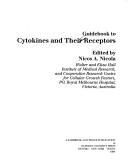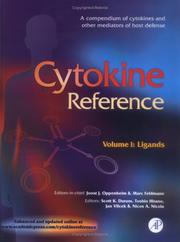| Listing 1 - 10 of 15 | << page >> |
Sort by
|

ISBN: 0121551423 9786611046316 1281046310 0080530206 9780121551421 9781435604919 1435604911 9781281046314 6611046313 9780080530208 Year: 2001 Publisher: San Diego Academic Press
Abstract | Keywords | Export | Availability | Bookmark
 Loading...
Loading...Choose an application
- Reference Manager
- EndNote
- RefWorks (Direct export to RefWorks)
Book
Year: 2001 Publisher: Boca Raton, FL : CRC Press [Chemical Rubber Company],
Abstract | Keywords | Export | Availability | Bookmark
 Loading...
Loading...Choose an application
- Reference Manager
- EndNote
- RefWorks (Direct export to RefWorks)
Immunity, Cellular. --- Anti-antibodies --- Buffers --- Chemokines --- Clone cells --- Cytokines --- Enzyme-linked immunosorbent assay --- Flow cytometry --- Receptors, cytokine --- Anti-antibodies --- Buffers --- Chemokines --- Clone cells --- Cytokines --- Enzyme-linked immunosorbent assay --- Flow cytometry --- Receptors, cytokine

ISBN: 1281046310 9786611046316 0080530206 0121551423 Year: 2001 Publisher: San Diego : Academic Press,
Abstract | Keywords | Export | Availability | Bookmark
 Loading...
Loading...Choose an application
- Reference Manager
- EndNote
- RefWorks (Direct export to RefWorks)
Completely revised and expanded, this second edition of The Cytokine FactsBook is the most up-to-date reference manual available for all current well-characterized interleukins, cytokines, and their receptors. An additional 52 cytokines are included, doubling the number of entries from the previous edition. The key properties of each cytokine are described and presented in a very accessible format with diagrams for each of the receptors. The Cytokine FactsBook includes free online access to the regularly updated Cytokine Webfacts. Cytokine Webfacts is a web-based comprehensive compendium of facts about cytokines and their receptors that includes a variety of data representations, such as text, signal pathway diagrams and 3D images. This exciting resource is integrated into other databases via hypertext links to provide a unique network, and contains a web-enabled version of RasMol for viewing structures.
Cytokines. --- Cytokines--Handbooks, manuals, etc. Cytokines--outlines. --- Receptors, Immunologic --- Intercellular Signaling Peptides and Proteins --- Proteins --- Receptors, Cell Surface --- Biological Factors --- Peptides --- Amino Acids, Peptides, and Proteins --- Membrane Proteins --- Chemicals and Drugs --- Cytokines --- Receptors, Cytokine --- Biology --- Health & Biological Sciences --- Microbiology & Immunology --- Cellular immunity --- Immune response --- Regulation --- Receptors, cytokine

ISBN: 0198599463 9780198599463 Year: 1994 Publisher: Oxford Oxford University Press
Abstract | Keywords | Export | Availability | Bookmark
 Loading...
Loading...Choose an application
- Reference Manager
- EndNote
- RefWorks (Direct export to RefWorks)
Cytokines --- Receptors --- Cytokines. --- Receptors, Cytokine. --- Cytokine Receptor --- Receptors, Cytokines --- Cytokine Receptors --- Cytokines Receptors --- Receptor, Cytokine --- Cellular Immune Response --- Cell-Mediated Immunity --- Cell Mediated Immunity --- Cell-Mediated Immunities --- Cellular Immune Responses --- Cellular Immunities --- Cellular Immunity --- Immune Response, Cellular --- Immune Responses, Cellular --- Immunities, Cell-Mediated --- Immunities, Cellular --- Immunity, Cell-Mediated --- Response, Cellular Immune --- Interleukin-12 --- Immunity, Cellular --- Receptors, Cytokine --- Lymphokines --- T-Lymphocytes --- Cellular immunity --- Immune response --- Regulation --- Histology. Cytology --- General biochemistry --- General embryology. Developmental biology --- Cytokine --- Cytokines - Receptors


ISBN: 0122526732 0122526708 9780122526701 9780122526732 Year: 2001 Publisher: San Diego, CA ; New York, NY ; Boston, MA : Academic Press,
Abstract | Keywords | Export | Availability | Bookmark
 Loading...
Loading...Choose an application
- Reference Manager
- EndNote
- RefWorks (Direct export to RefWorks)
Pharmacology. Therapy --- Allergy --- Cytokines --- 576.54 --- 577.27 --- Cellular immunity --- Immune response --- 577.27 Molecular bases of immunity. Molecular immunology --- Molecular bases of immunity. Molecular immunology --- 576.54 Cell interaction. Communication --- Cell interaction. Communication --- Receptors --- Regulation --- Ligands. --- Immunity. --- Immunity, Cellular. --- Cytokines - Receptors --- Immunity, Cellular --- Immunity --- Immunologic factors --- Proteins --- Receptors, cytokine
Book
ISBN: 1617378852 1603272666 9786612331046 1282331043 1603272674 Year: 2009 Publisher: Totowa, NJ : Humana Press,
Abstract | Keywords | Export | Availability | Bookmark
 Loading...
Loading...Choose an application
- Reference Manager
- EndNote
- RefWorks (Direct export to RefWorks)
Chemokine Receptors in Cancer summarizes the growing body of evidence that several chemokine receptors contribute to tumor behavior. Chemokine receptors were first identified on leukocytes and mediate directed migration of many host cells to sites of ligand expression. It is now well established that most malignant cells also express one or more chemokine receptor. This book describes our current understanding regarding how chemokine receptors contribute to tumor cell migration as well as cell survival and proliferation. The function of chemokine receptors expressed on host cells including antitumor immune effector cells as well as angiostatic and angiogeneic functions of chemokines acting on endothelial cells are described. The role of chemokine receptors that act as decoy receptors is also summarized. The therapeutic potential and challenges of targeting chemokine receptors or cognate ligands is also addressed.
Cancer cells --- Chemokines --- Receptors, Cytokine --- Antigens, CD --- Receptors, G-Protein-Coupled --- Diseases --- Angiogenesis Modulating Agents --- Growth Substances --- Receptors, Immunologic --- Antigens, Differentiation --- Receptors, Cell Surface --- Membrane Proteins --- Biological Markers --- Antigens, Surface --- Physiological Effects of Drugs --- Pharmacologic Actions --- Proteins --- Antigens --- Biological Factors --- Amino Acids, Peptides, and Proteins --- Chemicals and Drugs --- Chemical Actions and Uses --- Angiogenesis Inducing Agents --- Neoplasms --- Receptors, Chemokine --- Biology --- Health & Biological Sciences --- Medicine --- Pharmacy, Therapeutics, & Pharmacology --- Oncology --- Microbiology & Immunology --- Growth --- Regulation. --- Receptors --- Effect of drugs on. --- Effect of drugs on --- Regulation --- Chemokines. --- Drug receptors. --- Drugs --- Receptors, Drug --- Chemotactic cytokines --- Inflammatory peptides --- Intercrines --- Medicine. --- Cancer research. --- Oncology. --- Biomedicine. --- Cancer Research. --- Cell receptors --- Cytokines --- Inflammation --- Peptides --- Mediators --- Oncology . --- Tumors --- Cancer research
Book
ISBN: 1441927999 0387895191 9786612361234 1282361236 0387895205 Year: 2009 Publisher: New York, N.Y. : Austin, Tex. : Springer Science+Business Media ; Landes Bioscience,
Abstract | Keywords | Export | Availability | Bookmark
 Loading...
Loading...Choose an application
- Reference Manager
- EndNote
- RefWorks (Direct export to RefWorks)
Tumor necrosis factor (TNF) superfamily is a rapidly growing family of cytokines that interacts with a corresponding superfamily of receptors. Ligand-receptor interactions of this superfamily are involved in numerous biological processes ranging from hematopoiesis to pleiotropic cellular responses, including activation, proliferation, differentiation, and apoptosis. The particular response depends on the receptor the cell type, and the concurrent signals received by the cell. Worldwide interest in the TNF field surged dramatically early in 1984 with the cloning and defining of the profound cellular effects of the first member of this family, TNFa. Subsequently, the major influence of TNFa on the development and functioning of the immune system was established. Today, over 20 human TNF ligands and their more than 30 corresponding receptors have been identified. Few receptors still remain orphans. What has emerged over the years is that most TNF ligands bind to one distinct receptor and some of the TNF ligands are able to bind to multiple TNF receptors, explaining to some extent the apparent disparity in the number of TNF receptors and ligands. Yet, in spite of some redundancy in TNF ligand/receptor interactions, it is clear that in vivo spatial, temporal, and indeed cell- and tissue-specific expression of both ligands and their receptors are important factors in determining the precise nature of cellular physiological and pathological processes they control. Therapeutic Targets of the TNF Superfamily presents the state-of-the art account on the role of TNF superfamily members in the pathogenesis and their use in current intervention of cancers and autoimmune disease. This text will be highly valuable for investigators to understand the disease processes regulated by TNF superfamily members and to develop effective therapeutics. A view into the future, inspired by the comprehensive work presented in this volume, predicts that researchers studying TNF superfamily members will continue to make rapid progress in identifying relevant components to the disease process and new therapeutic strategies to target many human diseases including cancers, autoimmune disease and others.
Tumor necrosis factor --Agonists --Therapeutic use. --- Tumor necrosis factor. --- Tumor necrosis factor --- Autoimmune Diseases --- Tumor Necrosis Factors --- Receptors, Tumor Necrosis Factor --- Neoplasms --- Inflammation --- Drug Therapy --- Immune System Diseases --- Diseases --- Intercellular Signaling Peptides and Proteins --- Pathologic Processes --- Cytokines --- Receptors, Cytokine --- Therapeutics --- Pathological Conditions, Signs and Symptoms --- Peptides --- Biological Factors --- Proteins --- Analytical, Diagnostic and Therapeutic Techniques and Equipment --- Receptors, Immunologic --- Amino Acids, Peptides, and Proteins --- Chemicals and Drugs --- Receptors, Cell Surface --- Membrane Proteins --- Microbiology & Immunology --- Biology --- Health & Biological Sciences --- Agonists --- Therapeutic use --- Therapeutic use. --- Cachectin --- Lymphotoxin --- TNF (Immunology) --- Medicine. --- Immunology. --- Biomedicine. --- Biomedicine general. --- Immunobiology --- Life sciences --- Serology --- Clinical sciences --- Medical profession --- Human biology --- Medical sciences --- Pathology --- Physicians --- Glycoproteins --- Growth factors --- Macrophages --- Biomedicine, general. --- Health Workforce

ISBN: 9781588291721 1588291723 9781592598519 9786610358199 128035819X 159259851X Year: 2005 Publisher: Totowa, N.J. : Humana Press,
Abstract | Keywords | Export | Availability | Bookmark
 Loading...
Loading...Choose an application
- Reference Manager
- EndNote
- RefWorks (Direct export to RefWorks)
Cell death, or apoptosis, plays an important role in biological processes and disease and offers special opportunities to develop new therapies for cancer, autoimmune disease, stroke, heart attack, and Alzheimer's disease. In Death Receptors in Cancer Therapy, leading physician-scientists and basic researchers review in depth our latest understanding of the molecular events that regulate cell death, illuminating those molecules that provide targets for agonists or antagonists designed to modulate death signaling for therapeutic purposes. The authors focus on the extrinsic system of death receptors, their regulation and function, and their abnormalities in cancer. Topics of particlar interest include resistance to apoptosis, TRAIL signaling, death receptors in embryonic development, mechanisms of caspase activation, and death receptor mutations in cancer. Additional chapters address death signaling in melanoma, synthetic retinoids and death receptors, the role of p53 in death receptor regulation, immune suppression of cancer, and combination therapy with death ligands. Authoritative and up-to-date, Death Receptors in Cancer Therapy offers a timely compendium of cell death signaling pathways for those seeking either a basic understanding of apoptosis or the knowledge needed to develop new therapeutics that will activate or block death signaling in disease.
Neoplasms --- Cell Death --- Gene Therapy --- Receptors, Tumor Necrosis Factor --- Apoptosis --- Cell receptors --- Cancer --- Cellular signal transduction --- Apoptose --- Récepteurs cellulaires --- Transduction du signal cellulaire --- immunology --- therapy --- methods --- Molecular aspects --- Aspect moléculaire --- Kanker --- Kanker ; moleculaire aspecten --- Apoptosis. --- Cancer -- Molecular aspects. --- Cell receptors. --- Cellular signal transduction. --- Biological Therapy --- Genetic Engineering --- Diseases --- Investigative Techniques --- Cell Physiological Processes --- Receptors, Cytokine --- Cell Physiological Phenomena --- Receptors, Immunologic --- Analytical, Diagnostic and Therapeutic Techniques and Equipment --- Genetic Techniques --- Therapeutics --- Receptors, Cell Surface --- Phenomena and Processes --- Membrane Proteins --- Proteins --- Amino Acids, Peptides, and Proteins --- Chemicals and Drugs --- Methods --- Medicine --- Biology --- Health & Biological Sciences --- Cytology --- Oncology --- Molecular aspects. --- Cellular information transduction --- Information transduction, Cellular --- Signal transduction, Cellular --- Cell membrane receptors --- Cell surface receptors --- Receptors, Cell --- Medicine. --- Oncology. --- Medicine & Public Health. --- Tumors --- Clinical sciences --- Medical profession --- Human biology --- Life sciences --- Medical sciences --- Pathology --- Physicians --- Bioenergetics --- Cellular control mechanisms --- Information theory in biology --- Binding sites (Biochemistry) --- Cell membranes --- Cell death
Book
ISBN: 9783319140605 3319140590 9783319140599 3319140604 Year: 2015 Publisher: Cham : Springer International Publishing : Imprint: Springer,
Abstract | Keywords | Export | Availability | Bookmark
 Loading...
Loading...Choose an application
- Reference Manager
- EndNote
- RefWorks (Direct export to RefWorks)
Medicinal chemistry is both science and art. The science of medicinal chemistry offers mankind one of its best hopes for improving the quality of life. The art of medicinal chemistry continues to challenge its practitioners with the need for both intuition and experience to discover new drugs. Hence sharing the experience of drug research is uniquely beneficial to the field of medicinal chemistry. Drug research requires interdisciplinary team-work at the interface between chemistry, biology and medicine. Therefore, the topic-related series Topics in Medicinal Chemistry covers all relevant aspects of drug research, e.g. pathobiochemistry of diseases, identification and validation of (emerging) drug targets, structural biology, drugability of targets, drug design approaches, chemogenomics, synthetic chemistry including combinatorial methods, bioorganic chemistry, natural compounds, high-throughput screening, pharmacological in vitro and in vivo investigations, drug-receptor interactions on the molecular level, structure-activity relationships, drug absorption, distribution, metabolism, elimination, toxicology and pharmacogenomics. In general, special volumes are edited by well known guest editors.
Chemistry. --- Medicinal Chemistry. --- Receptors. --- Pharmaceutical Sciences/Technology. --- Pharmaceutical technology. --- Biochemistry. --- Cell receptors. --- Chimie --- Techniques pharmaceutiques --- Biochimie --- Récepteurs cellulaires --- Chemokines -- Receptors -- Effect of drugs on. --- Chemokines. --- Immunology. --- Natural immunity. --- Inflammation Mediators --- Receptors, Cytokine --- Investigative Techniques --- Cytokines --- Antigens, CD --- Receptors, G-Protein-Coupled --- Chemistry, Pharmaceutical --- Chemotactic Factors --- Pharmacology --- Biological Factors --- Intercellular Signaling Peptides and Proteins --- Receptors, Immunologic --- Receptors, Cell Surface --- Chemistry --- Antigens, Differentiation --- Analytical, Diagnostic and Therapeutic Techniques and Equipment --- Biological Science Disciplines --- Natural Science Disciplines --- Biological Markers --- Antigens, Surface --- Membrane Proteins --- Proteins --- Chemicals and Drugs --- Peptides --- Antigens --- Amino Acids, Peptides, and Proteins --- Disciplines and Occupations --- Drug Discovery --- Receptors, Chemokine --- Chemokines --- Biology --- Health & Biological Sciences --- Pharmacy, Therapeutics, & Pharmacology --- Microbiology & Immunology --- Chemotactic cytokines --- Inflammatory peptides --- Intercrines --- Medicinal chemistry. --- Proteins. --- Inflammation --- Mediators --- Pharmaceutical laboratory techniques --- Pharmaceutical laboratory technology --- Technology, Pharmaceutical --- Technology --- Cell membrane receptors --- Cell surface receptors --- Receptors, Cell --- Binding sites (Biochemistry) --- Cell membranes --- Biological chemistry --- Chemical composition of organisms --- Organisms --- Physiological chemistry --- Medical sciences --- Composition --- Proteins . --- Chemistry, Medical and pharmaceutical --- Drug chemistry --- Drugs --- Medical chemistry --- Medicinal chemistry --- Pharmacochemistry --- Proteids --- Biomolecules --- Polypeptides --- Proteomics
Book
ISBN: 1489993762 146141959X 9786613696861 1461419603 1280786477 Year: 2012 Publisher: New York : Springer,
Abstract | Keywords | Export | Availability | Bookmark
 Loading...
Loading...Choose an application
- Reference Manager
- EndNote
- RefWorks (Direct export to RefWorks)
Recently, the CXCR4/CXCL12-axis has been recognized as one of the pivotal adhesion pathways by which hematopoietic stem cells are retained in the bone marrow. CXCR4 antagonists with different chemical specification are being developed. Pharmacology research guides the way to the rational development of effective antagonists. One antagonist, plerixafor, is now clinically approved for stem cell mobilization of lymphoma and myeloma patients. This progress allows patients to receive potentially life-saving treatment which could not have been administered otherwise. Through early clinical studies it was recognized that CXCR4 antagonists also mobilize malignant hematopoietic cells, i.e. leukemia cells. In preclinical studies, a sensitization of mobilized leukemic cells to standard cytotoxic chemotherapy could be shown. CXCR4 antagonists are an exciting new class of compounds which are also used for the mobilization of angiogenic cells or for the treatment of solid tumors. This book provides concise reviews of novel developments, as well as possible future developments on CXCR4. .
Hematopoietic stem cells -- Transplantation. --- Stem cells --Transplantation. --- Stem cells --- Hematopoietic stem cells --- Cancer --- Receptors, CXCR --- Stem Cell Transplantation --- Receptors, HIV --- Biological Therapy --- Bone Marrow Cells --- Metabolic Phenomena --- Chemicals and Drugs --- Stem Cells --- Cells --- Hematopoietic System --- Receptors, Chemokine --- Cell Transplantation --- Phenomena and Processes --- Receptors, Virus --- Therapeutics --- Antigens, CD --- Receptors, Cytokine --- Anatomy --- Hemic and Immune Systems --- Receptors, G-Protein-Coupled --- Transplantation --- Analytical, Diagnostic and Therapeutic Techniques and Equipment --- Receptors, Cell Surface --- Receptors, Immunologic --- Antigens, Differentiation --- Membrane Proteins --- Surgical Procedures, Operative --- Proteins --- Antigens, Surface --- Biological Markers --- Amino Acids, Peptides, and Proteins --- Antigens --- Biological Factors --- Hematopoietic Stem Cells --- Receptors, CXCR4 --- Hematopoietic Stem Cell Mobilization --- Heterocyclic Compounds --- Hematopoietic Stem Cell Transplantation --- Metabolism --- Medicine --- Biology --- Health & Biological Sciences --- Oncology --- Cytology --- Therapeutic use --- Treatment --- Motility. --- Treatment. --- Cancer therapy --- Cancer treatment --- Cell motility --- Cell movement --- Cellular movement --- Motility of cells --- Therapy --- Movement --- Medicine. --- Cancer research. --- Pharmacology. --- Biomedicine. --- Cancer Research. --- Pharmacology/Toxicology. --- Biomechanics --- Cell physiology --- Oncology. --- Toxicology. --- Chemicals --- Pharmacology --- Poisoning --- Poisons --- Tumors --- Toxicology --- Cancer research --- Drug effects --- Medical pharmacology --- Medical sciences --- Chemotherapy --- Drugs --- Pharmacy --- Physiological effect
| Listing 1 - 10 of 15 | << page >> |
Sort by
|

 Search
Search Feedback
Feedback About UniCat
About UniCat  Help
Help News
News